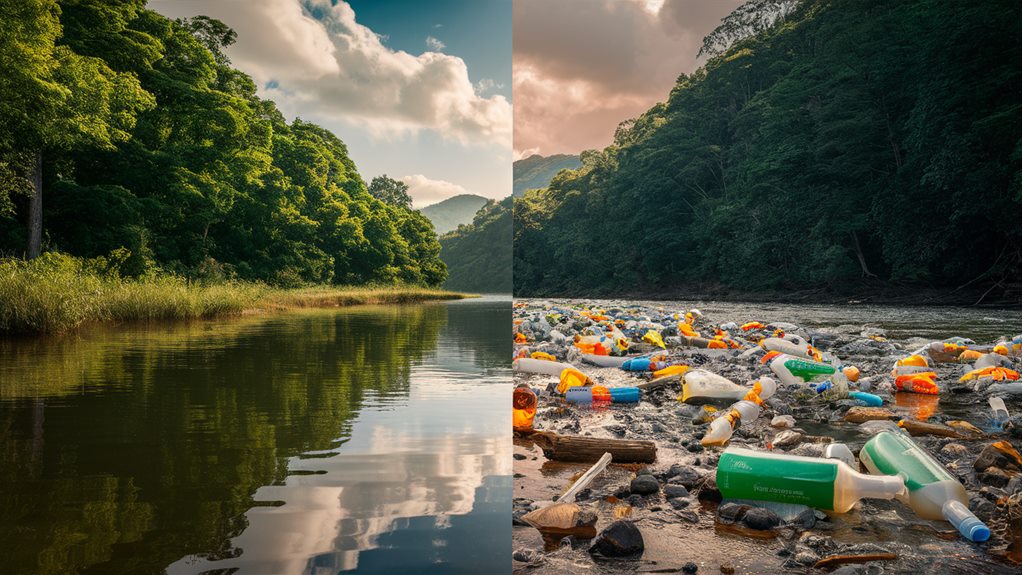Traditional cleaning products, filled with harmful chemicals like VOCs, phosphates, and non-biodegradable ingredients, can severely damage the environment. These substances not only pollute water bodies, leading to harmful algal blooms and aquatic toxicity, but they also degrade your indoor air quality. Frequent use exposes you to health risks, including respiratory problems and skin irritation. Additionally, these pollutants persist in the ecosystem, leading to long-term harm to marine life through bioaccumulation and soil contamination. Exploring alternative solutions and understanding the regulations might just reshape how you view the implications of your everyday cleaning choices.
Key Takeaways
- Traditional cleaning products contain VOCs and phosphates that degrade indoor air quality and contribute to water pollution.
- These products release chemicals that induce eutrophication, leading to algal blooms and oxygen depletion in aquatic ecosystems.
- Non-biodegradable ingredients persist in the environment, causing soil and water contamination.
- Residual chemicals from these products bioaccumulate in marine organisms, posing toxic effects and threatening biodiversity.
- Lack of transparency regarding ingredients in traditional cleaning products poses significant health risks to humans and harms aquatic life.
Chemical Composition of Cleaners
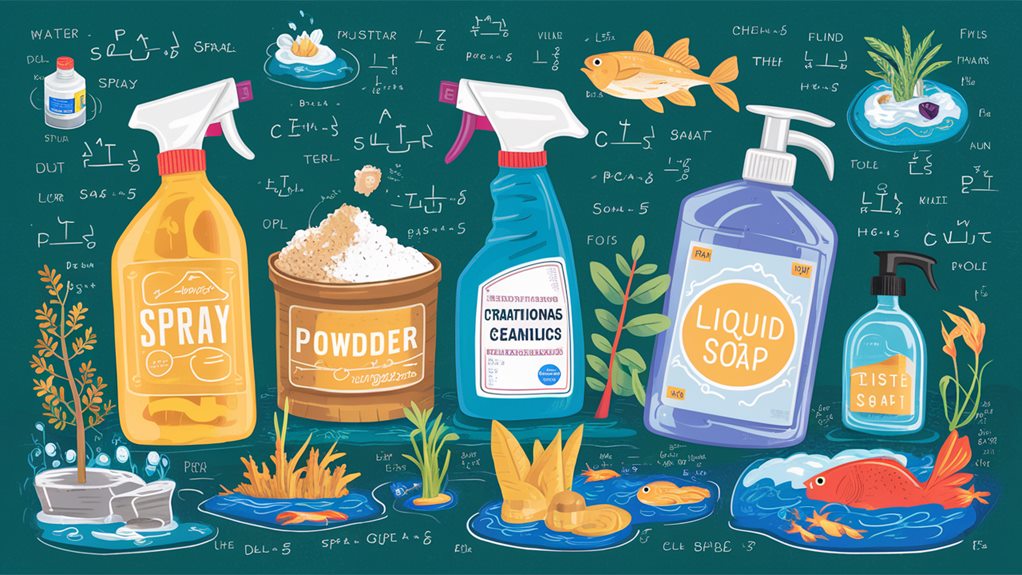
In examining the chemical composition of cleaners, it's important to understand that many contain volatile organic compounds (VOCs), phosphates, and other harsh chemicals. You're part of a community increasingly concerned with the environmental footprint of everyday products, and this awareness drives the demand for ingredient transparency in the products you use around your home. Many traditional cleaning products don't disclose their full ingredient lists, leaving you in the dark about the potential environmental and health impacts.
VOCs, commonly found in aerosol sprays and disinfectants, can evaporate into the air at room temperature, degrading indoor air quality and posing health risks. Additionally, many of these products can contribute to water pollution, as the harmful chemicals they contain often end up in waterways. Phosphates, though effective for removing stains and softening water, can create algal blooms in water bodies, severely damaging ecosystems.
You're not powerless in this situation. There's a growing array of green cleaning alternatives that aren't only effective but also kinder to the planet. These products avoid harsh chemicals, relying instead on natural ingredients like vinegar, baking soda, and citrus oils. For instance, plant-based laundry detergents are increasingly popular for their effectiveness and reduced environmental impact. Companies committed to these alternatives often practice full ingredient transparency, giving you the control to make informed choices that align with your values of environmental stewardship and community health.
Water Pollution and Detergents
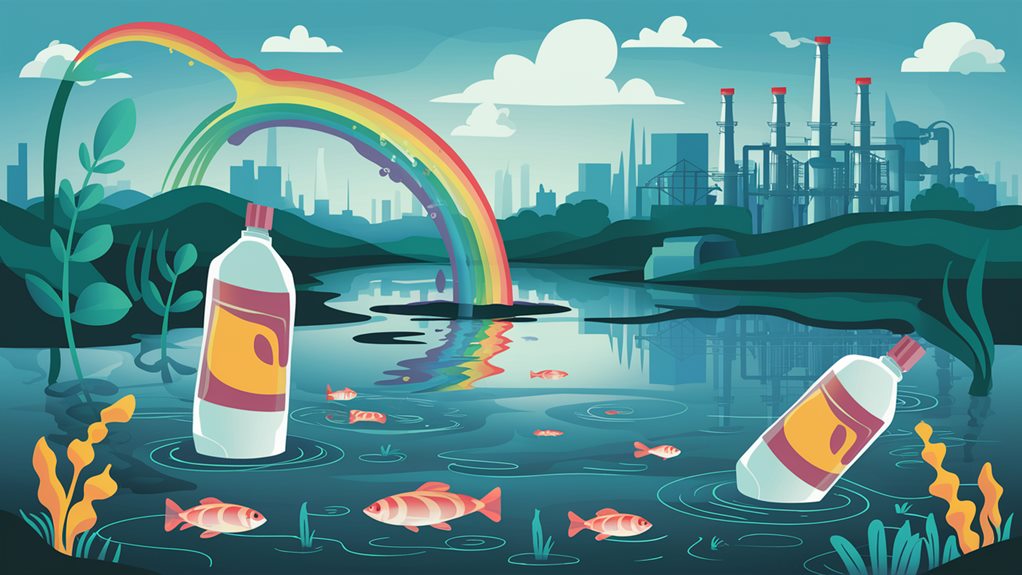
Detergents' role in water pollution highlights an important environmental issue that demands immediate attention. Every time you wash your clothes or clean your home, you're likely sending chemicals into the water system that can disrupt the delicate balance of marine ecosystems. These substances, primarily from detergents, don't always break down in wastewater treatment processes and end up in rivers, lakes, and oceans. Choosing eco-friendly cleaning products, such as those from brands like Seventh Generation, can notably mitigate this impact by using biodegradable ingredients that are less harmful to aquatic life.
You mightn't realize it, but the phosphates and surfactants in many detergents are particularly harmful. Phosphates, which are used to soften water and enhance cleaning efficiency, contribute to nutrient-loading in water bodies. This leads to excessive growth of algae, which depletes oxygen in the water and can kill fish and other aquatic life.
Surfactants, which help to break down dirt and oils, pose their own threat. They can damage the mucous membranes of fish and accumulate in the tissues of aquatic organisms, leading to long-term environmental damage.
Moreover, the presence of these chemicals in the water can compromise wastewater treatment efforts. Treatment plants aren't always equipped to filter out all synthetic chemicals, which means that untreated pollutants are discharged into natural water bodies. This not only affects wildlife but can also impact water quality for human use.
As a member of this planet, it's vital to be aware of the products you use and their broader environmental impacts. Opting for eco-friendly or phosphate-free detergents can notably reduce your household's contribution to water pollution. Together, by making informed choices, we can protect our marine ecosystems and support effective wastewater treatment.
Air Quality and Volatile Organics

When you use traditional cleaning products, you're often releasing volatile organic compounds (VOCs) into your home's environment. These VOCs contribute to the degradation of indoor air quality, posing health risks such as respiratory issues and allergic reactions.
Additionally, many conventional cleaners contain harmful additives like phosphates and synthetic fragrances that can further compromise air quality and trigger allergies. Studies indicate that long-term exposure can exacerbate or even lead to the development of chronic conditions, emphasizing the need for safer alternatives like eco-friendly multi-surface cleaners.
VOCs Release Effects
Many traditional cleaning products release volatile organic compounds (VOCs) that degrade indoor air quality to a considerable extent. When you use these products for routine cleaning, you're not just wiping away dirt and grime; you're also releasing chemicals that can greatly impact your respiratory health and the environment. VOCs aren't merely odors; they're a potent group of chemicals that vaporize at room temperature and can linger long after the cleaning process is complete.
The frequent use of products containing VOCs contributes to an accumulation of these compounds indoors, where you and your family spend most of your time. This exposure can exacerbate asthma, trigger allergies, and even lead to long-term health issues such as chronic respiratory problems. Understanding that these effects aren't just limited to personal health is crucial.
The release of VOCs affects broader environmental health, contributing to air pollution and smog formation outside your home.
Indoor Air Degradation
Several traditional cleaning products degrade indoor air quality by releasing volatile organic compounds (VOCs). As you work to keep your home clean, you're often unknowingly introducing an array of household contaminants that can harm your family's health. VOCs, which include chemicals like formaldehyde and benzene, aren't merely unpleasant odors; they represent a significant threat to the air you breathe indoors.
The impact of these compounds is heightened in poorly ventilated spaces. VOCs can linger, reacting with other indoor air elements to create secondary pollutants, which may be even more harmful than their predecessors. This scenario emphasizes the importance of effective ventilation strategies. Incorporating enhanced airflow can greatly reduce the concentration of VOCs inside your home.
Methods such as:
- Opening windows
- Using exhaust fans
- Ensuring your HVAC system includes proper filtration
are essential.
You're part of a community that values a safe, healthy home environment. By understanding the risks associated with traditional cleaning products and adopting smarter ventilation practices, you can protect and enhance your indoor air quality. Remember, creating a healthier home doesn't just benefit you; it fosters a sense of well-being for everyone who enters your space.
Impact on Aquatic Life

Pouring down drains across the globe, traditional cleaning products introduce harmful chemicals into waterways that pose a significant threat to aquatic life. These substances disrupt the balance of aquatic ecosystems, leading to harmful effects on both freshwater and marine environments. As you consider the products you use at home, it's essential to understand their broader environmental impact, especially on aquatic life which is critical for the health of our planet.
The introduction of pollutants like phosphates, nitrates, and harsh chemicals from everyday cleaners can lead to oxygen depletion in water bodies. This phenomenon, known as eutrophication, forces fish and other marine life to either adapt or perish. The survival challenge doesn't stop there; many chemicals also bioaccumulate in the tissues of aquatic organisms, leading to toxic effects that can decimate populations and disrupt marine biodiversity.
Moreover, the degradation of these chemicals often results in byproducts that are even more harmful than the original substances. For instance, when certain detergents break down, they form compounds that can cause hormonal disruptions in fish and other wildlife, leading to reproductive and developmental issues. This not only impacts individual species but can lead to broader implications for the entire marine food chain.
As a member of a global community, your choices matter. Opting for eco-friendly cleaning products isn't just about protecting your health; it's also about safeguarding our aquatic systems. By making informed decisions, you're taking a step towards nurturing the marine life that shares this earth with us, ensuring that water ecosystems continue to thrive and support diverse forms of life.
Soil Contamination Concerns
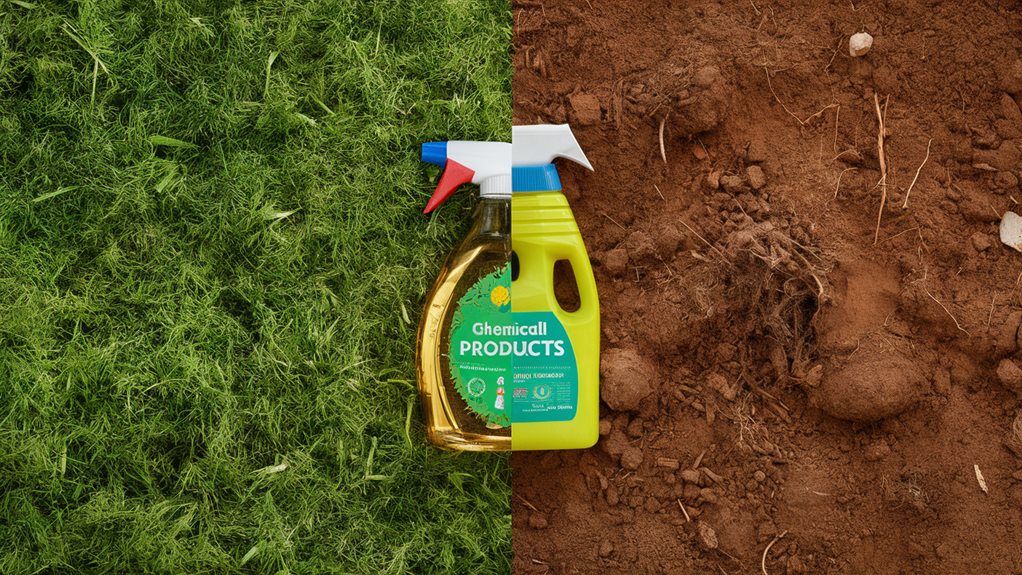
While considering the impact of cleaning products on aquatic life, it's also vital to address how these chemicals affect terrestrial environments. You mightn't realize it, but every time you use traditional cleaning products, you're potentially contributing to soil contamination. This happens through agricultural runoff and groundwater contamination, two substantial environmental concerns that directly impact the health of our ecosystems and, by extension, our own well-being.
When you wash away these chemicals, they don't just vanish. Instead, they often end up in our sewage systems, which can lead to agricultural runoff. This runoff flows into our soil and can disrupt the delicate balance of nutrients and microorganisms. It's not just about the soil losing its fertility; it's about the long-term effects such as changes in soil chemistry and structure, which can affect crop yields and food quality.
Moreover, the infiltration of these chemicals into the soil can lead to groundwater contamination. This means that chemicals from cleaning products can seep into aquifers, contaminating the water that might eventually come out of your tap. The presence of harmful chemicals in drinking water can pose significant health risks, including but not limited to, neurological disorders, reproductive issues, and cancer.
It's essential to understand that your choices in household cleaning products can have a broader impact than you might think. Opting for products that are labeled as environmentally friendly or using natural alternatives can greatly reduce these risks. By making informed decisions, you're not only protecting the environment but ensuring a healthier future for all.
Non-Biodegradable Ingredients
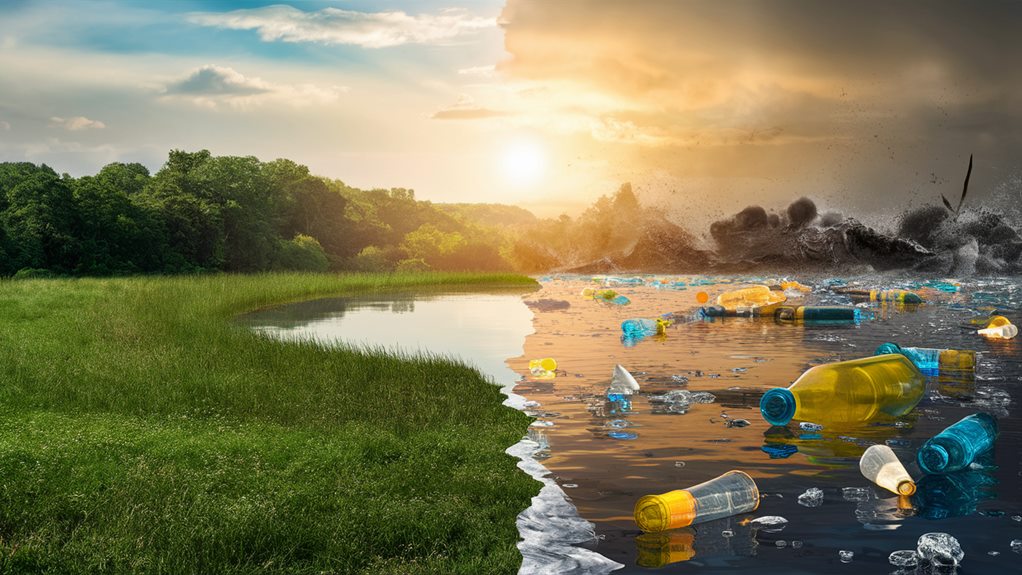
Although many consumers focus on the immediate effectiveness of cleaning products, it's important to take into account the long-term environmental impact of non-biodegradable ingredients. You're not just buying a product; you're endorsing its influence. Knowing what goes down your drain is as essential as what cleans your surfaces.
Non-biodegradable ingredients persist in the environment, failing to break down naturally, which leads to accumulation and potential ecological disturbances. These substances can contribute to significant environmental harm, affecting wildlife and ecosystems. As a conscientious consumer, your choices can drive change towards more sustainable practices.
Here are key points to ponder about non-biodegradable ingredients:
- Biodegradability Standards: These are crucial for evaluating the environmental impact of cleaning agents. Products meeting these standards are designed to break down naturally and minimize ecological harm.
- Environmental Labeling: Reliable labels like EcoLabel or Green Seal indicate products with certified environmental compliance, guiding you towards more sustainable choices.
- Longevity in the Environment: Non-biodegradable chemicals may persist for years, altering habitats and affecting biodiversity.
- Bioaccumulation Potential: These substances can accumulate in the bodies of wildlife, leading to toxic effects and disrupting food chains.
- Water Pollution: Residues from non-biodegradable cleaning products often reach waterways, contributing to pollution and affecting water quality.
Effects on Human Health

You may not realize it, but your everyday cleaning products can pose significant health risks. Exposure to certain chemicals in these products is linked to respiratory issues, including asthma and allergies, and can also cause severe skin irritation. Over time, the accumulation of these toxic substances in your body might lead to more serious, long-term health consequences.
Respiratory Issues Risk
Exposure to traditional cleaning products can notably increase your risk of developing respiratory issues. When you use these products, you're often exposed to a cocktail of chemicals that can harm your respiratory health. These substances can trigger or exacerbate asthma, lead to chronic respiratory problems, and even affect lung function over time.
Here's what you need to know about the risks:
- Asthma and Allergy Development: Frequent use of certain cleaning agents can heighten your sensitivity, leading to asthma or exacerbating existing allergies.
- Chronic Respiratory Conditions: Long-term exposure to harsh chemicals can contribute to the development of chronic obstructive pulmonary disease (COPD) and other respiratory conditions.
- Immediate Symptoms: Symptoms such as coughing, wheezing, and shortness of breath can occur shortly after exposure to chemical cleaners.
- Reduced Lung Function: Over time, sustained chemical exposure can decrease lung capacity and function.
- Vulnerable Groups at Higher Risk: Children, the elderly, and those with pre-existing health conditions are especially vulnerable to the effects of these chemicals.
Protecting your respiratory health means being mindful of the products you choose. Opting for cleaners with fewer chemicals can notably reduce your chemical exposure and help keep your lungs healthier.
Skin Irritation Concerns
Traditional cleaning products often contain irritants that can significantly affect your skin's health. If you're noticing redness, itching, or other forms of irritation after cleaning, you might be experiencing the impact of harsh chemicals like ammonia or chlorine bleach, which are common in many household cleaners. These substances can strip away oils from your skin, leading to dryness and cracking, which in turn makes you more susceptible to other skin conditions.
Particularly for those of you with increased allergen sensitivity, repeated exposure to these chemicals can worsen your symptoms. You're not just cleaning your home; you're also exposing your skin to potential allergens that can trigger reactions ranging from mild irritation to more severe dermatitis risks.
Dermatitis, especially contact dermatitis, occurs when allergens trigger an immune response, causing inflamed, sore, or itchy skin.
It's essential to understand the components of the products you're using and consider alternatives that might be gentler on your skin. Opting for cleaners labeled as "hypoallergenic" or those containing natural ingredients might reduce your exposure to harmful chemicals. Remember, protecting your skin isn't just about avoiding visible irritation; it's about ensuring your overall dermatological health remains uncompromised by the products that keep your living spaces clean.
Long-Term Health Effects
While skin irritation from cleaning products is an immediate concern, the chemicals in these products can also have more severe, long-lasting effects on your overall health. You're not alone in facing these risks; they're a shared concern, impacting communities worldwide. Raising public awareness about the potential dangers is essential for collective action and healthier choices.
Here are key long-term health effects that deserve your attention:
- Respiratory Issues: Continuous exposure can lead to chronic respiratory problems or exacerbate conditions like asthma.
- Cancer Risks: Certain chemicals in cleaning products are carcinogens, potentially increasing your risk of cancer.
- Reproductive Harm: Exposure to some substances has been linked to reproductive issues, affecting fertility and prenatal development.
- Neurological Damage: Neurotoxic effects can occur from prolonged exposure, impacting brain function and nerve operation.
- Endocrine Disruption: Chemicals can mimic or interfere with body hormones, leading to a myriad of health issues.
Being aware of these occupational hazards is crucial, especially if you're frequently using these products at work or home. The journey to safer alternatives begins with informed choices and advocating for regulations that prioritize health over convenience. Join the movement for safer cleaning practices; your health and community well-being depend on it.
Alternative Eco-Friendly Solutions
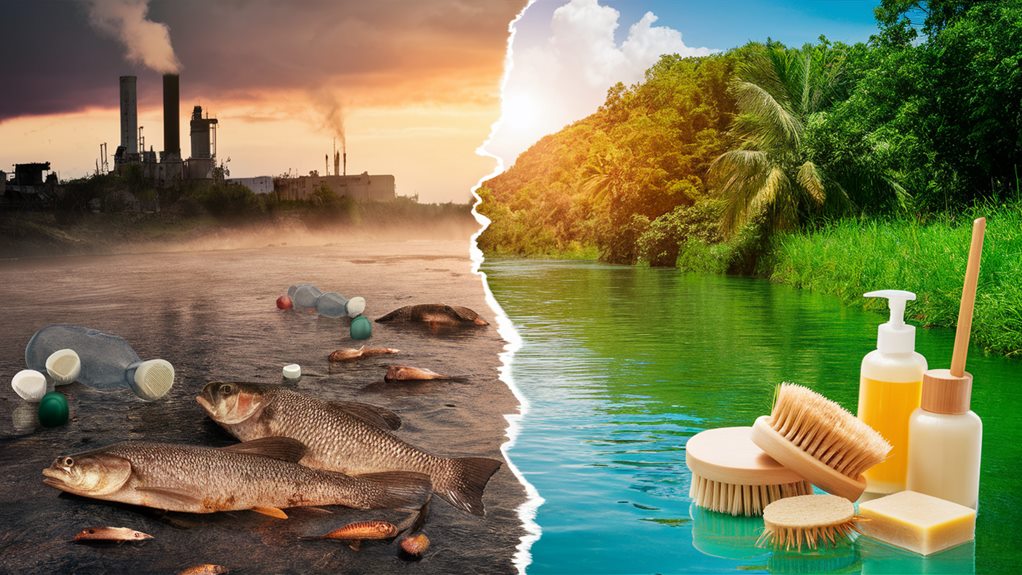
Turning to alternative eco-friendly solutions can greatly reduce the environmental footprint of your daily cleaning routine. You're aware of the hazardous effects of many traditional cleaning products, but mightn't know how accessible and effective green alternatives and sustainable solutions can be.
By choosing products labeled as eco-friendly, you're not only safeguarding your family's health but also contributing to a larger community committed to environmental preservation. These products typically avoid harsh chemicals, opting instead for natural ingredients that are much kinder to the planet.
For instance, cleaners made from vinegar, lemon, and baking soda provide a powerful solution to your cleaning needs without the residual harm to waterways and wildlife associated with phosphates and other harsh chemicals found in many conventional cleaners.
Moreover, sustainable solutions often involve minimalistic packaging to reduce waste. Companies might use recycled materials or even offer refillable options, allowing you to reuse plastic containers and reduce your overall plastic consumption. This approach not only lessens landfill waste but also diminishes the demand for new plastic production, a major contributor to pollution and greenhouse gas emissions.
Furthermore, integrating tools like microfiber cloths and biodegradable sponges into your cleaning routine enhances the lifecycle of the products you use. These items are durable, washable, and more environmentally sound than their disposable counterparts.
Embracing these alternatives doesn't just mean buying different products; it's about joining a movement. You become part of a proactive community striving for a healthier planet. Each choice may seem small, but collectively, they lead to significant environmental benefits, aligning your daily practices with your values for a sustainable future.
Regulatory Standards for Cleaners

You'll find that regulatory standards for cleaners vary greatly across the globe, posing substantial compliance challenges for manufacturers. As you navigate these regulations, it's essential to understand how eco-friendly certifications play a role in shaping product formulations and market access. This variability affects not only production but also the broader environmental impact of these cleaning products.
Global Regulatory Variations
Across the globe, regulatory standards for cleaning products vary considerably, impacting how manufacturers formulate and market their products to different regions. You're part of a global community where these variations influence not only product availability but also the environmental footprint and health implications of the products you use daily.
Understanding the differences in regulations can help you make informed choices and advocate for safer, more sustainable practices. Here's a quick look at key aspects:
- Policy Implications: Diverse regulations affect global harmonization efforts, complicating the creation of universally accepted standards.
- Consumer Preferences: Shifts in consumer demand influence regulatory changes, pushing for products that are both effective and environmentally friendly.
- Safety Standards: Countries impose varying levels of restrictions on substances, directly affecting product safety and marketability.
- Environmental Guidelines: Regulations focusing on biodegradability and toxicity help mitigate environmental impact, differing significantly from one country to another.
- Labeling Requirements: Inconsistent disclosure norms impact how well you understand a product's contents and safety level, varying widely across borders.
These factors shape market dynamics and directly influence how you experience and interact with cleaning products. Staying informed helps you navigate these complexities, ensuring you're part of a community that values health and sustainability.
Compliance Challenges
While varying global regulations shape the landscape of cleaning product standards, manufacturers face significant compliance challenges when adapting to these diverse rules. You're part of an industry where adhering to compliance regulations isn't just about ticking boxes; it's essential for ensuring consumer safety and maintaining your business's credibility.
Each country you operate in might've its own set of standards, which dictates everything from the chemical composition of the cleaners to their labeling and disposal.
Navigating through these regulations requires a detailed understanding and a proactive approach. For instance, what's permissible in one region could be banned in another. This means you've got to tailor your products meticulously to meet local demands without compromising on efficiency or safety.
It's not just about being compliant, but also about being a responsible manufacturer who values consumer trust and environmental safety.
Moreover, keeping up with industry standards can be just as challenging. These standards often influence legislative frameworks and can impact your product development directly. Staying ahead involves continuous research and development, ensuring that your products not only meet the current regulations but are also poised for future requirements.
It's a dynamic challenge that demands attention and adaptation, ensuring your place in the global market.
Eco-Friendly Certifications
Exploring the world of eco-friendly certifications, you must understand that these regulatory standards for cleaners are designed not only to protect the environment but also to guide manufacturers in sustainable practices. These certifications aren't just logos on a label; they represent a commitment to sustainability benefits and heightened consumer awareness.
When you choose products bearing these certifications, you're part of a larger community committed to environmental stewardship. Let's investigate what makes these certifications stand out:
- Transparency: Certified products must fully disclose their ingredients, ensuring you know what's in the products you use.
- Biodegradability: Products must break down naturally in the environment, reducing pollution and harm to wildlife.
- Resource Conservation: Manufacturing processes are required to minimize energy and water usage, contributing to overall sustainability.
- Chemical Restrictions: Harmful chemicals are banned, and safer alternatives are used, protecting both ecosystems and human health.
- Third-Party Verification: Independent organizations verify claims, ensuring that products meet strict environmental and safety standards.
Understanding these key aspects helps you make informed decisions, aligning your household choices with your values for a healthier planet. By supporting eco-certified products, you also encourage companies to maintain responsible practices, fostering a sustainable future.
Future Trends in Cleaning Technology

As we look to the future, several promising trends in cleaning technology are poised to revolutionize the industry. You're about to witness an era where smart cleaning technology and sustainability aren't just buzzwords but the foundation of cleaning practices. These innovations aim not only to enhance cleaning results but also to reduce the environmental footprint associated with traditional methods.
Smart cleaning devices equipped with sensors and AI are making their way into both household and industrial settings. These tools can detect the level of cleanliness and the type of cleaning required, adjusting their functions to optimize water and energy use. This not only boosts efficiency but also guarantees that resources are utilized judiciously, contributing to a sustainable future.
Moreover, green cleaning innovations are redefining what it means to clean effectively. Biodegradable ingredients and non-toxic chemicals are becoming the standard in new product formulations. Companies are increasingly adopting these green solutions, driven by consumer demand for safer and more environmentally friendly products. This shift isn't just about responding to market trends; it's about being part of a larger movement towards environmental stewardship.
Efficiency is also key in the emerging landscape of cleaning technology. New technologies are designed to do more with less, from reducing the amount of chemical waste to cutting down on the time it takes to clean spaces effectively. This means less strain on both natural resources and human labor.
As you embrace these changes, you're joining a community committed to preserving our planet for future generations. It's a powerful movement, and together, we're paving the way for a cleaner, greener world.
Frequently Asked Questions
How Do Cleaning Products Affect Indoor Plants?
When you use cleaning products around your home, they can impact your indoor plants. The chemicals may degrade air quality, affecting plant growth negatively.
Some products release volatile organic compounds that can hinder photosynthesis by blocking sunlight absorption and damaging plant tissues.
To safeguard your green friends, opt for natural cleaners and guarantee good ventilation when cleaning. You'll create a safer environment for both your plants and yourself.
Can Cleaning Chemicals Alter the Taste of Homegrown Vegetables?
You might wonder if your homegrown vegetables taste off lately.
Yes, cleaning chemicals can indeed alter their flavor. When used near your garden, these substances can leach into the soil, causing contamination.
This not only impacts plant growth but leaves chemical residues on the veggies themselves, subtly changing their natural flavors.
Always be cautious where you use harsh chemicals if you're aiming to keep your garden's produce pure and tasty.
What Are the Economic Costs of Using Traditional Cleaners?
When you consider the economic costs of using traditional cleaners, it's not just about the price tag. You're also looking at health implications from exposure to harsh chemicals, which can drive up medical expenses. Plus, consumer behavior is shifting towards eco-friendly products, potentially increasing costs if you stick with outdated options.
A detailed cost analysis should factor in these environmental consequences and potential long-term expenses tied to health and market trends.
How Do Traditional Cleaners Impact Pet Health?
Traditional cleaners often contain strong chemicals that can impact your pet's health. Exposure to these substances can trigger pet allergies and worsen respiratory issues. It's important to recognize the signs, such as increased scratching or breathing difficulties, which indicate sensitivity to these cleaners.
Opting for natural substitutes can help guarantee your home stays a safe haven for your furry friends, fostering a healthier environment for everyone in your household.
Are There Cultural Differences in Cleaning Product Preferences?
Yes, there are notable cultural differences in cleaning product preferences. You'll find that cultural preferences often dictate the types of products used, reflecting local values and the availability of certain ingredients.
Cultures with a heightened awareness of environmental impact might lean towards eco-friendly products. By understanding and respecting these preferences, you can feel a deeper connection to various communities, promoting a sense of belonging while making informed choices that align with your values.
Conclusion
As you step into the future, imagine a world where every splash of detergent doesn't poison our rivers or a breath indoors doesn't pollute our lungs. The shift is essential, and it's happening. Regulations tighten, and green solutions rise, promising a cleaner, safer planet. Will these trends continue, reducing our ecological footprint? The answer hinges on our choices today. Embrace eco-friendly alternatives, and we'll forge a path that veers away from environmental calamity towards sustainable living.

